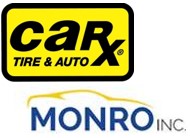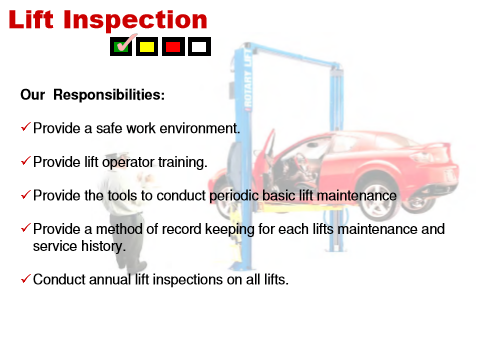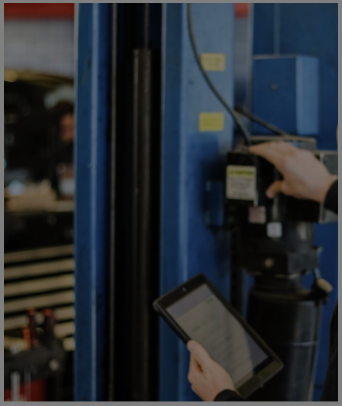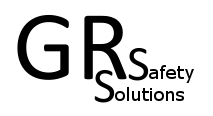Title Page
-
Conducted on
-
STORE#
-
Location
-
INSPECTOR NAME
Instructions
-
As an employer, we want to give our employees the safest and healthiest workplace environment possible. It is the law. The Occupational Safety and Health Administration (OSHA) sets and imposes strict safety guidelines to ensure that American workers do not labor under needlessly hazardous conditions. These guidelines are most often enforced in the form of stiff fines. In today's "lawsuit-happy" workplace environment, injury lawyers are finding that non-compliant businesses are the easiest targets for negligence-based tort suits. To protect the company and our employees, we need to keep up with required training, recommended routine maintenance schedules and annual inspections. The Automotive Lift Institute (ALI), whom OSHA references relative to lift certification, recommends that car lifts undergo annual inspections administered by qualified lift inspectors. These inspectors are specifically trained on procedures outlined by the ALOIM-2008 National Standard Covering Safety Requirements for Lift Operation, Inspection and Maintenance. In order for lift inspections to be valid, all such inspections, repairs, service and routine maintenance must be documented, detailed, placed on file and kept up-todate. Proof of proper lift operator training must also be presented for each employee.
The follow training and Information has been developed to provide that guidance. -
MULTI-POINT LIFT INSPECTION
undefined
-
MULTI-POINT DIGITAL LIFT INSPECTION
-
BAY #
-
MODEL #
-
LIFT SERIAL#
LIFT TYPE
-
SURFACE OR INGROUND
-
Choose Lift Type
- SINGLE POST
- 2 POST
- 4 POST
- SCISSOR
- LOW/MID RISE
- HINGE/PARALLELOGRAM
- MOBILE COLUMN
- MOD 30
- FORE & AFT
undefined
-
CAPACITY
-
CAPACITY DECAL LOCATED ON LIFT
-
ACCESSIBILITY OF OWNERS MANUALS, SAFETY INSTRUCTIONS, & LIFTING POINT INFORMATION
Common Inspection Points All Lifts
-
Accessibility and readability of safety warning labels on the lift
-
Confirm adequacy of clearances around the lift
-
Examine structural components including welds for signs of fatigue, overloading, misuse
-
Inspect all controls for proper operation (including limit switches, timing belts, encoders, potentiometers)
-
Check fluid levels and contamination (including proper PSI settings)
-
Examine electrical components & wiring (including emergency cut-offs & function of disconnects)
-
Check all points requiring lubrication
-
Check for proper installation and condition of spotting dish
-
On lifts employing adapters, check condition and proper operation
-
Are extended height adapters available
-
Check all accessories for construction, labeling and proper operation
-
Check all fastening devices for tightness, including anchor bolts (follow manufactures torque specs)
-
On lifts incorporating overhead structures, verify the safety shutoff operates properly
-
Operate the lift and check the operation of the lift locks, including latch cables
-
On lifts incorporating secondary latch devices, check operation and condition
Hoses, Piping, Tubing & Hydraulic Cylinders
-
Check all accessible piping, tubing, hose, valves, fittings for visible leaks & proper routing
-
Check hydraulic cylinders for smooth operation and leaks
Cables, Chains and Sheaves
-
Inspect all cables and/or chains for frays, stretching, corrosion, cracking and proper adjustment
-
Inspect sheaves for proper alignment and cracks (ensure sheave shields are in place)
-
Check the tracking and touting of hoses, cables and chains
Lifts using swing arms, runways or platforms
-
On lifts using swing arms, check telescoping stops
-
On lifts requiring swing arm restraints, check for proper function and abnormal wear
-
On lifts using runways, check to ensure proper operation of all features
-
On lifts equipped with platforms, railings or stairways, check to ensure proper operation of all features
In ground Lifts
-
Report fluid accumulation and/or debris in sub-floor pits or enclosures
-
On air-oil lifts check for low oil control
-
Inspect locking legs/struts for proper attachments, function or damage and housings free from debris
-
On lifts that incorporated trench covers, verify proper operation and abnormal deformation
-
Check integrity of tamper resistant seals on relief valves
-
Inspect plungers for signs of rust, corrosion or damage (run full stroke to observe operation)
-
Confirm single point operation of multiple powered posts
Hydraulic Portable Lifts
-
Check screw drive systems for wear, operation and lubrication (including wear nut or screw brake)
-
Check mobility of individual units
-
Run lift through full cycle and verify proper shut off at top and bottom of travel
LOCK OUT TAG OUT
-
IF ANY FAILURES ARE MARKED LOCK OUT TAG OUT OF LIFT IS RECOMMENDED!
-
Use of this lift is "Not Recommended" until repairs are made
-
Lift Inspector Signature










